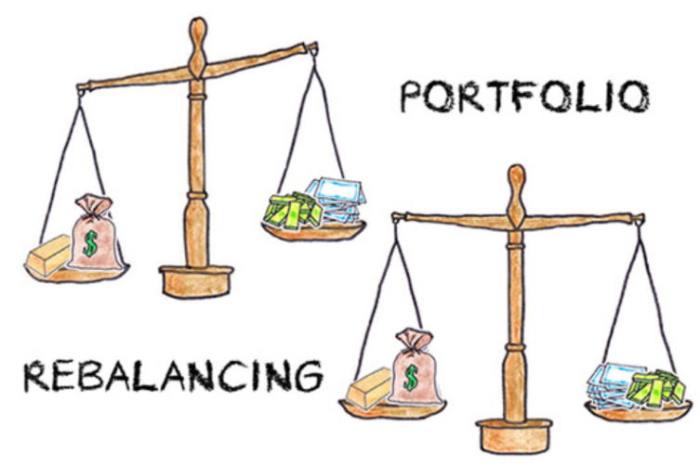Diving into the world of portfolio rebalancing tips, get ready to level up your investment game with our comprehensive guide. From understanding the importance of rebalancing to exploring different strategies, this article will equip you with the knowledge needed to make informed decisions about your portfolio.
Importance of Portfolio Rebalancing

When it comes to stacking that paper and securing those bags, keeping your investment portfolio in check is key. Portfolio rebalancing is like hitting the refresh button on your financial game plan, ensuring you stay on track to reach those money goals.
Benefits of Regular Rebalancing
- Manage Risk: By rebalancing your portfolio, you can adjust your asset allocation to maintain a level of risk that aligns with your risk tolerance. This helps prevent your portfolio from being too heavily weighted in one particular area, reducing the impact of market fluctuations.
- Maximize Returns: Regularly rebalancing allows you to take advantage of market movements by selling high and buying low. This strategic move can boost your overall returns over time.
- Align with Financial Goals: As your financial goals and priorities evolve, so should your investment strategy. Rebalancing helps ensure that your portfolio is in sync with your changing needs, whether it’s saving for retirement, buying a house, or funding that dream vacation.
Portfolio Rebalancing Strategies
When it comes to rebalancing your portfolio, there are several strategies you can consider. Each strategy has its own set of pros and cons, so it’s important to understand them before deciding which approach works best for you.
Calendar-based Strategy
- With a calendar-based strategy, you rebalance your portfolio at specific time intervals, such as quarterly or annually.
- Pros: Provides a disciplined approach and helps maintain a consistent investment strategy over time.
- Cons: May not take into account changes in market conditions or individual asset performance.
Percentage-based Strategy
- In a percentage-based strategy, you rebalance your portfolio when the allocation of your assets deviates from your target percentages.
- Pros: Allows you to maintain your desired risk level and ensures your portfolio stays aligned with your investment goals.
- Cons: Requires regular monitoring and adjustment, which can be time-consuming.
Asset Allocation-based Strategy
- With an asset allocation-based strategy, you rebalance your portfolio based on changes in the overall market conditions or economic outlook.
- Pros: Helps you adapt to macroeconomic trends and adjust your portfolio accordingly.
- Cons: Requires a good understanding of market dynamics and the ability to make informed decisions based on economic indicators.
Determining the frequency of rebalancing should be based on your individual risk tolerance and investment goals. Consider factors such as market volatility, your investment time horizon, and your comfort level with risk. By choosing the right rebalancing strategy and frequency that aligns with your financial objectives, you can effectively manage your portfolio for long-term success.
Asset Allocation Tips
When it comes to portfolio rebalancing, asset allocation plays a crucial role in determining the overall risk and return profile of your investments. By strategically diversifying your portfolio across different asset classes, you can effectively manage risk and potentially increase your returns over the long term.
Significance of Asset Allocation
Asset allocation involves spreading your investments across various asset classes such as stocks, bonds, real estate, and cash equivalents. This helps reduce the impact of market fluctuations on your portfolio and ensures that you are not overly exposed to any single asset class. By maintaining a balanced allocation, you can achieve a more stable and consistent performance over time.
Diversification for Risk Reduction and Return Maximization
Diversifying your portfolio across different asset classes can help reduce risk by offsetting losses in one asset class with gains in another. For example, when stocks are facing a downturn, bonds or real estate investments may perform better, providing a buffer against losses. This diversification can also enhance returns by capturing the growth opportunities offered by different asset classes at different times.
Optimal Asset Allocation Models
For investors with a low risk tolerance, a conservative asset allocation model may involve a higher allocation to bonds and cash equivalents, with a smaller portion allocated to stocks. On the other hand, investors with a higher risk tolerance may opt for an aggressive allocation model with a larger proportion invested in stocks for potential higher returns, despite increased volatility.
Rebalancing Tools and Resources
When it comes to managing your investment portfolio, having access to reliable tools and resources can make the rebalancing process much smoother. Let’s take a look at some of the options available to investors.
Portfolio Management Software
- One popular choice for investors is Personal Capital, which offers a comprehensive platform for tracking and managing investments. It provides tools for analyzing asset allocation and rebalancing your portfolio.
- Wealthfront is another option that not only offers automated portfolio rebalancing but also includes tax-loss harvesting features to optimize your returns.
- For those who prefer a more hands-on approach, platforms like TD Ameritrade and E*TRADE provide robust tools for rebalancing your portfolio based on your preferences and investment goals.
Role of Robo-Advisors
Robo-advisors play a significant role in automating the rebalancing process for investors, making it easier to maintain a well-diversified portfolio. These digital platforms use algorithms to monitor your investments and automatically adjust your asset allocation to stay on track with your financial objectives. Some benefits of using robo-advisors for portfolio rebalancing include:
- Time-saving convenience: Robo-advisors handle the tedious task of rebalancing for you, allowing you to focus on other aspects of your financial planning.
- Cost-effective solutions: Many robo-advisors offer low fees compared to traditional financial advisors, making them an affordable option for investors.
- Objective-driven rebalancing: Robo-advisors take emotions out of the equation and rebalance your portfolio based on data and predetermined criteria, ensuring a disciplined approach to investing.